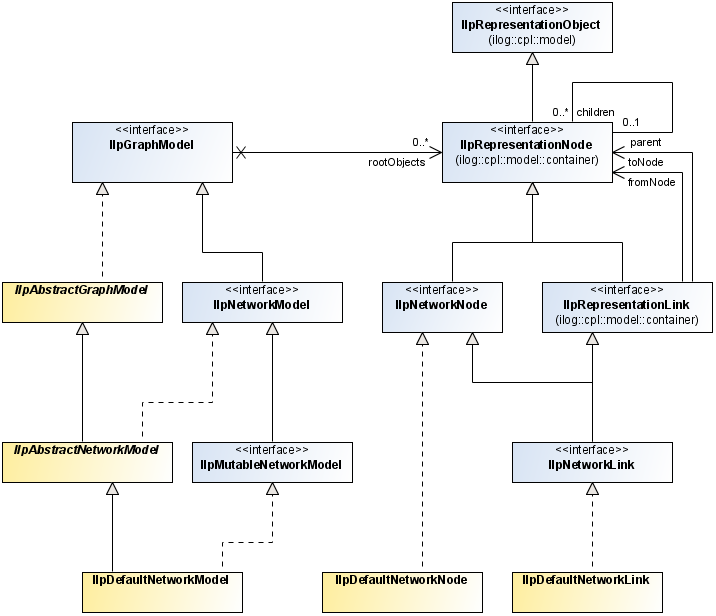The model contains the representation objects used to produce the
graphic objects in the view. The model describes the end points of
links, and as such it models the topology of the network. The model
allows the view to access contained objects through the method getChildren. The model provides support for
load-on-demand; that is, for adding child objects asynchronously
when expanding network objects through the class IlpExpansionStrategy.
Classes of the network model
The interface IlpNetworkModel is implemented by the class
IlpDefaultNetworkModel. This class is
automatically created when you instantiate IlpNetwork. JViews TGO provides the
following interfaces for creating nodes and links:
- IlpNetworkNode for nodes
- IlpNetworkLink for links
JViews TGO supplies
default implementations of these interfaces.
The following figure shows the classes
used by the network model.

Classes used by the network model
Creating nodes and links in the network model
When you want to create a new node or
link, use the default implementations:
To create a linkset, create several links
with the same end nodes.
To set the end nodes of a link, apply the methods
setFromNode
(for the start node) and
setToNode
(for the end node).
A link cannot be displayed unless it has
end nodes, but you can create the link before you create the end
nodes.
The following examples show how to use the
classes for creating nodes and links.
How to create a node
IlpDefaultNetworkNode node = new IlpDefaultNetworkNode(MyAttributes,null); network.setPosition(node,new IlpPoint(100,200), IlpPositionSource.BACKEND); model.addRootObject(node);
How to create a link
IlpDefaultNetworkLink link = new IlpDefaultNetworkLink(MyAttributes,null); link.setFromNode(node1); link.setToNode(node2); model.addRootObject(link);
For convenience, the main methods of IlpNetworkModel and IlpMutableNetworkModel are also
accessible from IlpNetwork. Thus, the following
statements are equivalent:
network.getModel().addRootObject(node);
and
network.addRootObject(node);